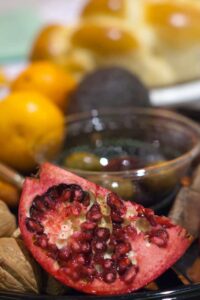 Here are the Top 10 quick and useful suggestions from Hazon, to make your Tu B’Shvat more healthy and sustainable. To find out more information and suggestions from Hazon for Tu B’Shvat, visit the Hazon Tu B’Shvat Resource Page.
Here are the Top 10 quick and useful suggestions from Hazon, to make your Tu B’Shvat more healthy and sustainable. To find out more information and suggestions from Hazon for Tu B’Shvat, visit the Hazon Tu B’Shvat Resource Page.
1 – Tu B’Shvat Recipes
[toggle title=”Israeli Wine and Fruit Soup“]
Recipe originally from the Jew and the Carrot
If you prefer whole fruit, add the oranges to cooled soup.
- 4 cups dry red or rose wine (or 2½ cups fruity dry white or rose wine and 1½ cups dry red wine)
- 2 pints fresh or 40 ounces frozen raspberries or cherries
- 44 ounces canned mandarin oranges
- 1½ cups orange juice or water
- ½ cup lemon juice
- 6 tablespoons quick-cooking tapioca
- 2 (3-inch) sticks cinnamon (optional)
Bring all ingredients to a gentle boil, stirring occasionally.
Lower heat and simmer for 10 minutes.
Serve warm or chilled.
Variation: To thicken soup with cornstarch — Omit tapioca. Dissolve 2 tablespoons cornstarch in ½ cup water; stir into boiling soup; and cook over medium-low heat, stirring constantly, until clear.
[/toggle]
[toggle title=”Moroccon Orange Salad“]
Recipe originally from The Jew and the Carrot
Salad:
5 medium (3 cups/720 ml) navel oranges or tangerines, peeled and segmented
2 medium red onions, thinly sliced (1½ cups/360 ml)
1 head romaine or butter lettuce or 1 bunch spinach, torn into bite-size pieces
About 5 cups greens, such as 2 bunches watercress, 2 bunches radicchio, or 6 ounces (170 grams) baby arugula, torn into bite-size pieces
Dressing
- ¼ cup (60 ml) olive oil
- ¼ cup (60 ml) vegetable oil
- ¼ cup (60 ml) fresh orange juice
- 2 tablespoons (30 ml) fresh lemon juice or red wine vinegar
- 2 to 3 tablespoons (30 to 45 ml) honey or sugar or ½ teaspoon (2.5 ml) Dijon mustard
- 1 teaspoon (5 ml) grated orange zest
- 1 teaspoon (5 ml) salt
- 1 tablespoon (15 ml) fresh or ½ teaspoon (2.5 ml) dried rosemary, basil, cilantro, mint, or thyme or ½ to 1 teaspoon (2.5 to 5 ml) ground cumin
- ¼ cup (60 ml) chopped fresh mint or cilantro (optional)
Divide the lettuce and watercress between serving plates or place on large platter.
Toss together the oranges and onions and place on greens.
Combine all the dressing ingredients and drizzle over the salad.
Variations: Add 2 peeled and sliced avocados, 2 cups sliced cooked beets, 1½ cups chopped pitted dates, 1 sliced large bulb fennel, 1 pound julienned peeled jicama, or 20 to 24 pitted and sliced black olives.
[/toggle]
[toggle title=”Cous Cous with Dried Fruit & Nuts“]
Recipe originally from The Jew and the Carrot
- 1 pound (2 2/3 cups) instant couscous (not Israeli style)
- 4 cups boiling water
- ½ cup granulated sugar
- ½ to 1 teaspoon ground cinnamon
- ¼ cup (½ stick) butter or margarine, melted
- ¾ cup (3.5 ounces) raisins
- ¾ cup (5 ounces) chopped pitted dates
- ¾ cup (3.5 ounces) chopped dried apricots
- ¾ cup (3.75 ounces) chopped blanched almonds
- ¾ cup (3 ounces) chopped walnuts or 1/3 cup pine nuts
- about 2 cups almond milk or hot milk
- additional ground cinnamon for garnish
Pour boiling water over couscous. Cover and let stand for 10 minutes.
Stir the sugar and cinnamon into the butter. Pour over the couscous, tossing to coat. Stir in the raisins, dates, apricots, almonds, and pine nuts. Gradually add enough of the almond milk to moisten the couscous.
Mound the couscous on a large platter and sprinkle with the additional cinnamon.
[/toggle]
2 – Go Out and Plant!
Tu B’Shvat is a great time to start your garden, and gives you sufficient time start growing so that you can put it to use during Pesach! So, take the time during this holiday to plant with the family and start your family garden where you will have your very own home grown fruits and veggies. If you don’t have a place to garden, that is no excuse! There are plenty of ways to grow veggies and plants in an indoor garden. Check out ways to start your indoor garden from a gardening expert!
3 – Celebrate the Trees
Tu B’Shvat is often viewed as the New Year of the trees, so take this opportunity to celebrate the nature that surrounds you! For a fun family or community activity, take pictures of trees in the winter and see if you can identify the trees without their leaves. Since Tu B’Shvat can be viewed as a “birthday” of trees, find the age of trees in your yard or neighborhood by using this calculation tool.
4 – Test Your Environmental Impact
Use Tu B’Shvat to test your knowledge on local, environmental issues. Allow Tu B’Shvat to open a door to finding more about your local habitat and ways to be more environmentally friendly and sustainable.
5 – Host a Sustainable Tu B’Shvat Seder
Joining family and friends, host a seder using the Hazon Tu B’Shvat haggadah and sourcebook! You can add to your Sustainable Tu B’Shvat Seder by serving local, organic wine: see our list of kosher organic wines. You can also go vegetarian for your Sustainable Tu B’Shvat Seder, check out this great JCarrot article for some winter soup options and read this for some creative vegan options.
6 – Bake Sustainable Tu B’Shvat Challah
Get creative with your challah by adding one, or many, of the seven species (see Sustainable Seven Species for Tu B’Shvat post). To get really creative, try decorating your challah with a free-formed pomegranate out of dough.
7 – Reuse and Recycle
In modern times, Tu B’shvat has been transformed into a holiday embracing nature, which allows us to focus our intentions on many environmental areas. In addition to supporting sustainable eating, try to cut down waste by using reusable, or compostable, dishes and recycle when possible. For resources and suggestions, visit the Hazon Food Guide.
8 – Compost
Collect leftover fruit and vegetable scraps from your Tu B’Shvat seder and add them to your compost pile (or bring them to a composting facility). You’re kicking off the new year of the trees by contributing to soil fertility and the cycles of life!
9 – Use Meals as Midrash
Use Tu B’Shvat as a platform to have meaningful and useful conversations with the family and friends at your table. Read this JCarrot article to learn more about how to tell stories with food through Midrash.
10 – Eat Local
If you live in an area with a variety of seasonal, winter offerings, use this to your advantage by eating local. In the south, citrus fruits are in season and can provide a great addition to the Tu B’Shvat celebration: try citrus curls in your drinks, lemon curd for desert, or roast chicken with oranges and lemons inside.
[green_message]
For more Tu B’Shvat recipes, activities, ideas, and suggestions, visit the Hazon Tu B’Shvat Resource Page.
[/green_message]
